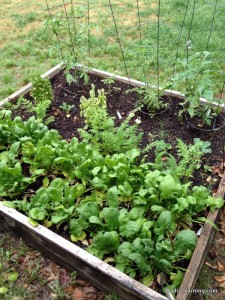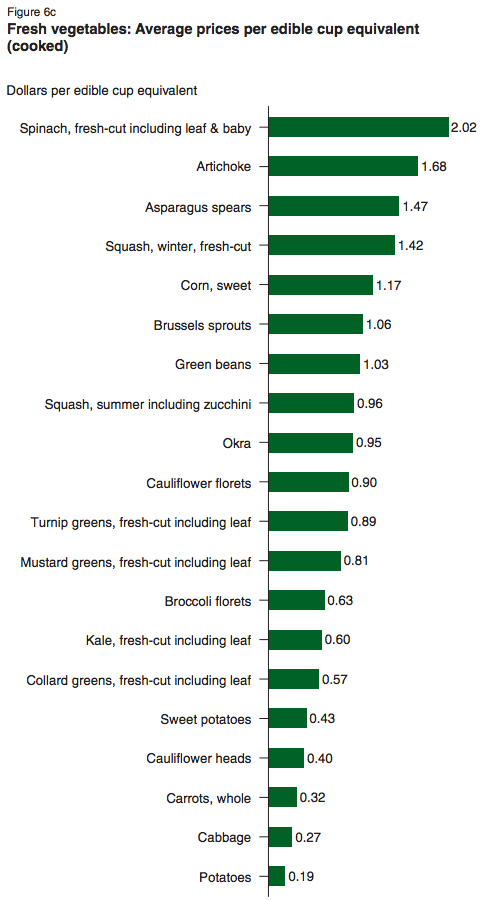The Most Bang For Your Buck: Homegrown Vegetables
I was working in the big garden last week and got to thinking about the costs involved in having a backyard garden and what would be the most cost effective plants to have in a garden. I have written about backyard gardening before (Favorite Things Friday: Backyard Gardening) and explored the costs of setting up a garden and the equipment involved, but which plants offer the most ‘bang for your buck?’ Here is what I’ve found based on my experiences and some of the research that is readily available:
Best Value / Easy to Grow
Spinach is one of the easiest things to grow in a garden and can give you an amazing return for your investment. A pack of good spinach seeds costs between $2 and $3 and will yield at least 2 dozen plants. Spinach is a nutrient dense food that continues producing until the weather gets really hot. Our spinach plants are hitting the end of their growth cycle and have produced at least 10 different harvests of spinach as well as many quick snacks for the girls and I while we were playing in the backyard. Planting a few spinach seeds each week could help offset the harvest times and maturing of the plants. The USDA found that spinach was among the more expensive vegetables, costing $2.02 per cooked cup. (I have included their chart below.) Spinach would be on my list of basic vegetables in a garden because it is easy to grow, nutrient dense and cost effective.
Squash is another cost effective plant for the backyard garden, if space is not an issue. Summer squash like yellow and zucchini squash are hardy. In our Texas heat they can take a beating during the heat of the day and then rebound at night. I tend to favor plants that provide a continual harvest like spinach and squash plants. Using the cost per cooked cup chart above, squash ranks in the middle of the pack. Summer squash has a fair amount of nutrients and will retain more antioxidants if you steam it instead of boiling or microwaving.
Okra is another easy to grow plant if you have the space. We have had good success with okra over the years and it can be cooked and prepared in a variety of ways. The plant does really well though out our summer heat here in Texas. Okra provides a unique set of nutrients and has high fiber content. Many people have “okraphobia” or a fear of the ooze that is associated with cooked okra. Alton Brown did an entire episode of Good Eats about okra and teaches you how to minimize okra slime and prepare cooked, pickled and fried okra in the episode.
Corn is another cost efficient food that is also kid friendly. In the USDA research, corn had a relatively high cost per cooked cup. Corn is also fairly hardy once the plant has become established. It is best planted in blocks instead of long rows so it more effectively pollinates. For those who are worried about all the GMO stuff, growing your own corn is a good way to make sure you know what you are eating. Corn plants can be a bit more challenging to work with since it can take a long time to get to harvest.
Low Value Veggies
I was surprised to find that tomatoes were not very cost effective to grow in the backyard. Let me preface my findings with this statement – Backyard tomatoes are the tastiest tomatoes you will ever eat. With that said, large tomatoes are not cost effective to grow in the backyard. They are fun and they taste delicious, but you won’t get as much bang for your buck as you will with other vegetables. (Remember tomatoes are technically a fruit.) The most cost effective type of tomatoes are heirloom varieties of cherry tomatoes. Cherry tomatoes mature quickly, are packed with nutrients and typically are plentiful to harvest. Large tomatoes risk impact from heat, birds (and other critters), and sometimes plants just don’t produce. Tomatoes are fun to grow but don’t offer as much value for the end product.

Our daughter harvesting potatoes with my Dad this year. Potatoes may not be cost effective but harvesting them makes priceless memories.
Potatoes also all in the category of low cost efficiency in the backyard garden. Production from potato plants can be hit and miss. Homegrown potatoes are tasty but it takes a lot of potato plants and space to grow a good harvest. You can also see that potatoes are at the bottom of the USDA cost per cup data.
Onions are also among the veggies that might be better to buy at the store. Onions are really easy to grow when grown from sets (young onion plants). Onions typically don’t need much water or attention but the cost benefit of growing your own is minimal.
Beans would also fall into the category of offering little bang for your buck. This category would cover all kinds of beans and legumes. The plants are typically hardy and produce well but it takes a lot of plants to produce a sustainable harvest and the effort in preparing them to eat can be time consuming as well. Dried beans are readily available and cheap. This is another garden staple that is tasty but not necessarily cost effective.
Conclusion
I’d be curious to hear your thoughts because I know a good number of you have your own backyard gardens. These are my own findings based on growth and production in our garden, value research from the USDA, and ease of preparing the final product. (Note: I didn’t include herbs in this post, but they offer perhaps the best dollar value in a backyard garden. Very little nutritional value but amazing and easy savings.)
These cost analysis posts tend to be some of my most popular posts. You might be interested in my article about the cost of the eggs from our backyard chickens or my analysis of how much it costs me to mow my own lawn. I have some future posts I am developing about why we didn’t find a travel trailer to be cost effective for our family and some research I have been doing on maintaining a cost efficient lawn in Texas.
If you found this post to be interesting, would you consider sharing it using the buttons below? Thanks!



We will be starting our own square foot garden soon and we are excited about that. One of my earliest childhood memories is digging potatoes with my Grandaddy, so I did love that picture that you included today. It seemed magical to me that the dirt could produce food!
I have the same memory with my Dad. There is something very magical about harvesting potatoes (and carrots too.) It’s like opening a present. You’ll have to let me know how the square foot gardening goes for you. I have really enjoyed ours and plan on adding another 4×4 square next year.
I’ve been considering starting my own square foot garden. My mom has always had different gardens -fruits/veggies and flowers- and I’ve always enjoyed the different fruits and veggies we’ve gained through that but I’ve never done it for myself. I do a lot of cooking and it’s nice when I can use items that were pulled from my own backyard. We have a couple of basil plants that I pick from pretty often and that definitely beats purchasing basil in store where it gets pretty pricey for a small amount of product.
I really like these “cost effective” posts!
I’m glad someone else enjoys the odd variety of things I cost analyze. Beryl I think you’d really enjoy having your own small garden. I bet you know a guy that could get you some lumber if you decided to do a raised bed garden. I’m right there with you on the herbs. Fresh herbs are staggeringly expensive for something that will go bad in a week or so. Thanks for commenting!
I so strongly agree with you about most of your top picks. Give me spinach, squash, okra, tomatoes, and onions and I’ll give you a different dish every day for at least 2 months! I do understand the lack of cost effectiveness w/ tomatoes, but no store bought ones compare to the taste of homegrown (due largely to the time from ripe to table, having been picked to ripen enroute, but losing flavor for being picked early). Give me those home grown selections ANY day of the week! BTW this Alton Smith guy? Sort of the PeeWee Herman of food? He didn’t mention my favorite way to eat okra: boiled w/ real butter (a little) and salt!
Haha Ted! Alton Brown is more like the Mr. Wizard of food science. But I can see the whole Pee Wee Herman thing with all his props and bits. Two months of recipes eh? That is a lot of variety.
Good analysis Jon. I am growing tomatoes, bell peppers, banana peppers, blueberries, strawberries, and satsumas right now. I also have a juvenile mango and avocado tree that I am starting out. Cost-wise, I would do much better going to the grocery, there is no doubt in my mind. The learning curve has been steep and expensive But the learning process for my kids and I has been invaluable.
But the learning process for my kids and I has been invaluable.
Thanks Chris! That’s awesome that you have a mango and an avocado tree. We could save some real money with an avocado tree. I had to look up satsumas…didn’t realize it was a type of mandarin. Those would be great to have as well! Sounds like you have quite the garden/orchard going! And you’re right, the best value is teaching your kids about where real food comes from!
I think another factor is personal preference–I am more than happy to work hard to have a good green bean harvest, because I like homecanned green beans so much better than anything I can buy. And now that we made 5 GALLONS of homemade salsa last year, my husband turns up his nose at the store bought kind. So…we are officially spoiled. I do take into consideration how expensive a vegetable is in the store, when I’m deciding what to grow–that’s why we grow spinach, sugar snap peas, and okra. And have you ever priced fresh shelled purple hull peas! Super expensive!
I do take into consideration how expensive a vegetable is in the store, when I’m deciding what to grow–that’s why we grow spinach, sugar snap peas, and okra. And have you ever priced fresh shelled purple hull peas! Super expensive!
5 gallons of salsa?!? How many tomatoes did you grow??? I should have probably said something about purple hull peas. We have some in our garden for that very reason…they are crazy expensive.
The other problem with potatoes is that, depending on your soil type, then can taste like, well, dirt. NJ soil is great for tomatoes but produces the worse tasting potatoes I’ve ever had.
I hadn’t thought about that Edward…that is a very good point! I really appreciate all your good comments on my posts!